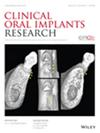Evaluation of the Relationship Between Intake of Proton Pump Inhibitors and Peri‐Implant Bone Microstructure by Using Fractal Analysis: A Retrospective Case–Control Study
IF 5.3
1区 医学
Q1 DENTISTRY, ORAL SURGERY & MEDICINE
引用次数: 0
Abstract
ObjectivesProton pump inhibitors (PPIs) have been suggested to influence bone metabolism and osseointegration. This study aimed to assess the long‐term effects of PPI usage on trabecular bone patterns around dental implants through fractal analysis of periapical radiographs.Material and MethodsThis retrospective, matched case–control study analyzed a database of 27 PPI users (87 dental implants) and established a control group of 27 nonusers (88 dental implants), matching them by age, sex, smoking status, total follow‐up duration, and history of augmentation procedures. The final study population included 54 patients with a total of 175 dental implants, all of which were from the same brand and identical in composition and surface treatment. The primary predictor variable was PPI use, while the outcome measures included implant survival rate, crestal bone loss (CBL), and fractal dimension (FD) values assessed on periapical radiographs.ResultsThree PPI users experienced implant failure during a mean follow‐up period of 76.9 months, whereas no failures occurred in the nonuser group (用分形分析评价质子泵抑制剂摄入量与种植体周围骨微观结构的关系:回顾性病例对照研究
目的质子泵抑制剂(PPIs)影响骨代谢和骨整合。本研究旨在通过根尖周x线片的分形分析来评估PPI使用对种植体周围骨小梁形态的长期影响。材料和方法本回顾性匹配病例对照研究分析了27名PPI使用者(87颗种植体)的数据库,并建立了27名非PPI使用者(88颗种植体)的对照组,根据年龄、性别、吸烟状况、总随访时间和隆胸史进行匹配。最终的研究人群包括54名患者,共175颗种植体,所有种植体均来自同一品牌,成分和表面处理方式相同。主要预测变量是PPI的使用,而结果指标包括种植体存活率、牙冠骨丢失(CBL)和根尖周围x线片评估的分形维数(FD)值。结果在平均76.9个月的随访期间,3名PPI使用者出现了植入失败,而非PPI使用者组没有发生失败(p > 0.05)。同样,两组间CBL值无显著差异(p > 0.05)。然而,在最终随访时,PPI使用者的平均(标准差)FD值为1.14(0.07),非PPI使用者的平均(标准差)FD值为1.19(0.05),差异有统计学意义(p < 0.01)。结论本研究结果提示PPI的使用可能对种植体周围骨代谢产生不利影响。临床医生应警惕接受PPI治疗的患者颌骨可能发生的小梁改变。
本文章由计算机程序翻译,如有差异,请以英文原文为准。
求助全文
约1分钟内获得全文
求助全文
来源期刊

Clinical Oral Implants Research
医学-工程:生物医学
CiteScore
7.70
自引率
11.60%
发文量
149
审稿时长
3 months
期刊介绍:
Clinical Oral Implants Research conveys scientific progress in the field of implant dentistry and its related areas to clinicians, teachers and researchers concerned with the application of this information for the benefit of patients in need of oral implants. The journal addresses itself to clinicians, general practitioners, periodontists, oral and maxillofacial surgeons and prosthodontists, as well as to teachers, academicians and scholars involved in the education of professionals and in the scientific promotion of the field of implant dentistry.
 求助内容:
求助内容: 应助结果提醒方式:
应助结果提醒方式:


